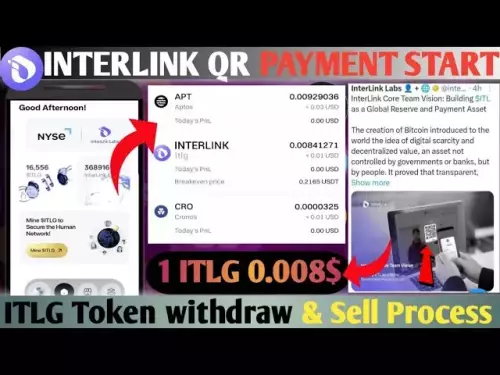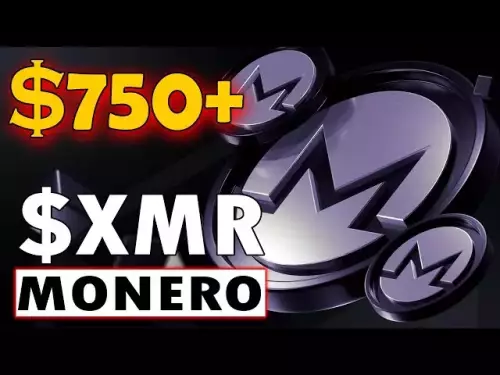-
 bitcoin
bitcoin $107208.295278 USD
-1.54% -
 ethereum
ethereum $3874.629914 USD
-1.38% -
 tether
tether $1.000440 USD
0.03% -
 bnb
bnb $1089.465513 USD
-5.53% -
 xrp
xrp $2.327672 USD
-1.65% -
 solana
solana $184.766505 USD
-0.73% -
 usd-coin
usd-coin $1.000076 USD
0.02% -
 tron
tron $0.310632 USD
-1.99% -
 dogecoin
dogecoin $0.187615 USD
-1.60% -
 cardano
cardano $0.633389 USD
-2.75% -
 ethena-usde
ethena-usde $0.999553 USD
0.03% -
 hyperliquid
hyperliquid $35.608231 USD
-4.13% -
 chainlink
chainlink $16.876114 USD
-3.98% -
 stellar
stellar $0.312239 USD
-0.91% -
 bitcoin-cash
bitcoin-cash $473.262969 USD
-7.09%
What does the increase in the withdrawal volume of Quant(QNT) exchanges mean? Is it a sell signal?
Increased withdrawal volume of QNT from exchanges may indicate security concerns or long-term holding, but it's not a definitive sell signal; context is key.
Apr 30, 2025 at 10:43 pm

The increase in the withdrawal volume of Quant (QNT) from exchanges can be a significant indicator for investors and traders within the cryptocurrency market. This phenomenon often sparks curiosity and concern among market participants, leading to questions about its implications and whether it should be interpreted as a sell signal. In this article, we will delve into the meaning behind the increased withdrawal volume of QNT, explore the potential reasons behind this trend, and discuss whether it should be considered a sell signal.
Understanding Withdrawal Volume
Withdrawal volume refers to the amount of cryptocurrency that is being moved from exchange wallets to private wallets. When there is an increase in the withdrawal volume of a particular cryptocurrency like QNT, it means that more holders are transferring their tokens away from exchanges. This can be observed through blockchain explorers and exchange data analytics tools.
The significance of withdrawal volume lies in its potential to indicate the behavior and sentiment of token holders. When holders move their tokens to private wallets, they are typically doing so for one of several reasons, which we will explore in the following sections.
Reasons for Increased Withdrawal Volume
There are several reasons why holders might increase their withdrawal volume of QNT from exchanges. Understanding these reasons can provide valuable insights into the market dynamics and the potential implications for the token's price.
Security Concerns: One of the primary reasons for moving tokens to private wallets is security. Exchanges are often targets for hackers, and holding tokens on an exchange can be riskier than storing them in a private wallet. If holders believe that the security of their QNT is at risk, they may choose to withdraw their tokens to a more secure environment.
Long-Term Holding: Another reason for increased withdrawal volume could be a shift towards long-term holding. Investors who believe in the long-term potential of QNT might move their tokens to private wallets to hold them for an extended period. This behavior can be seen as a vote of confidence in the project's future.
Preparation for Staking or Other Uses: QNT holders might also withdraw their tokens from exchanges to participate in staking, governance, or other uses that require tokens to be held in private wallets. If there are upcoming events or opportunities that require QNT to be held off-exchange, this could lead to an increase in withdrawal volume.
Market Sentiment and Speculation: Sometimes, an increase in withdrawal volume can be driven by market sentiment and speculation. If holders believe that the price of QNT is about to rise, they might move their tokens to private wallets to avoid selling pressure on exchanges. Conversely, if they anticipate a price drop, they might withdraw their tokens to avoid potential losses.
Is Increased Withdrawal Volume a Sell Signal?
The question of whether an increase in withdrawal volume should be considered a sell signal is complex and depends on various factors. While it can provide valuable insights, it should not be the sole basis for making investment decisions.
Context Matters: The context in which the withdrawal volume increases is crucial. If the increase is accompanied by other bearish indicators, such as declining trading volume or negative news about the project, it might be more likely to be a sell signal. However, if the increase is part of a broader trend of long-term holding or security concerns, it might not necessarily indicate a bearish outlook.
Market Dynamics: The overall market dynamics and the behavior of other cryptocurrencies should also be considered. If similar patterns are observed across multiple cryptocurrencies, it might be a broader market trend rather than a specific signal for QNT.
Historical Data: Analyzing historical data can provide insights into how past increases in withdrawal volume have correlated with price movements. If there is a consistent pattern of increased withdrawal volume leading to price drops, it might be more likely to be a sell signal.
Investor Sentiment: Finally, understanding the sentiment of QNT holders and the broader community can provide additional context. If there is a general sense of optimism or pessimism about the project, this can influence the interpretation of withdrawal volume data.
How to Monitor Withdrawal Volume
Monitoring the withdrawal volume of QNT can be done through various tools and platforms. Here is a step-by-step guide on how to do so:
Choose a Blockchain Explorer: Start by selecting a reliable blockchain explorer that supports QNT. Examples include Etherscan for Ethereum-based tokens like QNT.
Locate QNT Transactions: Navigate to the section of the blockchain explorer that displays transactions for QNT. This might be under a tab labeled 'Tokens' or 'ERC-20 Tokens.'
Filter for Withdrawals: Use the search or filter options to focus on transactions that are withdrawals from exchanges. You can often identify these by looking for transactions from known exchange addresses to private wallet addresses.
Analyze the Data: Once you have filtered the transactions, analyze the data to identify trends in withdrawal volume. Look for patterns over time and compare the current withdrawal volume to historical data.
Use Exchange Data Analytics Tools: In addition to blockchain explorers, consider using exchange data analytics tools like CoinMetrics or CryptoQuant. These platforms provide more detailed insights into exchange flows and can help you track withdrawal volume more effectively.
Cross-Reference with Other Data: Finally, cross-reference the withdrawal volume data with other market indicators, such as trading volume, price movements, and news about the project. This will give you a more comprehensive view of the market dynamics.
Potential Impact on QNT Price
The impact of increased withdrawal volume on the price of QNT can vary depending on the underlying reasons for the withdrawals. Here are some potential scenarios:
Reduced Selling Pressure: If holders are moving their QNT to private wallets for long-term holding or security reasons, this can reduce the selling pressure on exchanges. With fewer tokens available for sale, the price of QNT might increase if demand remains constant or grows.
Increased Demand for Staking: If the increased withdrawal volume is driven by upcoming staking opportunities or other uses that require tokens to be held off-exchange, this could lead to increased demand for QNT. As more holders participate in these activities, the price might rise due to the reduced supply on exchanges.
Speculative Movements: If the increase in withdrawal volume is driven by speculation about future price movements, the impact on the price can be more unpredictable. If holders are withdrawing their tokens in anticipation of a price increase, this might lead to a short-term price surge. However, if they are withdrawing to avoid potential losses, it could contribute to a price drop.
Market Sentiment: The overall market sentiment and the behavior of other cryptocurrencies can also influence the impact of increased withdrawal volume on QNT's price. If the broader market is bullish, the increased withdrawal volume might be seen as a positive sign. Conversely, if the market is bearish, it might be interpreted more negatively.
Frequently Asked Questions
Q: Can increased withdrawal volume be a sign of an upcoming token burn or similar event?A: Yes, increased withdrawal volume can sometimes be a sign of an upcoming token burn or similar event. If holders are aware of an upcoming event that will reduce the total supply of QNT, they might move their tokens to private wallets to participate in the event or to hold onto their tokens during the burn. However, this is just one possible reason, and other factors should be considered as well.
Q: How can I differentiate between withdrawals for security reasons and withdrawals for other purposes?A: Differentiating between withdrawals for security reasons and other purposes can be challenging. One way to do this is by analyzing the timing and volume of the withdrawals. If there is a sudden spike in withdrawal volume following a security breach or negative news about an exchange, it is more likely to be driven by security concerns. Additionally, if the withdrawals are spread out over time and not concentrated around specific events, they might be more indicative of long-term holding or other purposes.
Q: Are there any tools that can help predict the impact of increased withdrawal volume on QNT's price?A: While there are no tools that can predict the impact of increased withdrawal volume with certainty, there are several platforms that can provide valuable insights. Tools like CoinMetrics, CryptoQuant, and Glassnode offer detailed data on exchange flows and other market indicators. By analyzing this data in conjunction with other factors, such as market sentiment and historical price movements, you can make more informed predictions about the potential impact on QNT's price.
Q: How often should I monitor the withdrawal volume of QNT?A: The frequency with which you should monitor the withdrawal volume of QNT depends on your investment strategy and risk tolerance. If you are a short-term trader, you might want to check the withdrawal volume daily or even more frequently to stay on top of market trends. For long-term investors, weekly or monthly checks might be sufficient. Regardless of your strategy, it's important to consider withdrawal volume as part of a broader analysis of market conditions.
Disclaimer:info@kdj.com
The information provided is not trading advice. kdj.com does not assume any responsibility for any investments made based on the information provided in this article. Cryptocurrencies are highly volatile and it is highly recommended that you invest with caution after thorough research!
If you believe that the content used on this website infringes your copyright, please contact us immediately (info@kdj.com) and we will delete it promptly.
- Bitcoin, Traders, and Whales: Navigating a Shifting Crypto Landscape
- 2025-10-19 02:25:14
- HUGS Presale Crypto: Can Milk & Mocha Deliver a 100x ROI?
- 2025-10-19 02:25:14
- Robinhood, Tokenized Assets, and DeFi Investors: A New Era?
- 2025-10-19 02:30:11
- Natembeya, the Odinga Family, and Raila's Enduring Legacy: A Gesture of Unity
- 2025-10-19 02:30:11
- Baby Shark Universe: Riding the Metaverse Wave with a Gamified Token
- 2025-10-19 02:35:16
- Cardano and Digitap: Price Predictions and the Rise of Crypto-Banking
- 2025-10-19 02:45:12
Related knowledge

Practical parameter settings for a Bitcoin multi-timeframe moving average system
Sep 18,2025 at 10:54pm
Optimizing Timeframe Combinations for Bitcoin Trading1. Selecting appropriate timeframes is crucial when building a multi-timeframe moving average sys...

How can I filter out false breakouts in Dogecoin high-frequency trading?
Sep 22,2025 at 01:00am
Understanding False Breakouts in Dogecoin Trading1. A false breakout occurs when Dogecoin's price appears to move beyond a defined support or resistan...

Techniques for identifying tops and bottoms in the Bitcoin on-chain NVT model
Sep 20,2025 at 07:54pm
Understanding the NVT Model in Bitcoin Analysis1. The Network Value to Transactions (NVT) ratio is often described as the 'P/E ratio' of the cryptocur...

What does the surge in open interest in Bitcoincoin futures mean?
Sep 20,2025 at 11:18pm
Understanding the Surge in Dogecoin Futures Open Interest1. A surge in open interest within Dogecoin futures indicates a growing number of active cont...

How can I use the Ethereum USDT premium to gauge market sentiment?
Sep 18,2025 at 11:55pm
Understanding the Ethereum USDT Premium1. The Ethereum USDT premium refers to the price difference between USDT (Tether) traded on Ethereum-based plat...

What should I do if Ethereum staking yields decline?
Sep 20,2025 at 06:18am
Understanding the Causes Behind Declining Ethereum Staking Yields1. The Ethereum network transitioned to a proof-of-stake consensus mechanism with the...

Practical parameter settings for a Bitcoin multi-timeframe moving average system
Sep 18,2025 at 10:54pm
Optimizing Timeframe Combinations for Bitcoin Trading1. Selecting appropriate timeframes is crucial when building a multi-timeframe moving average sys...

How can I filter out false breakouts in Dogecoin high-frequency trading?
Sep 22,2025 at 01:00am
Understanding False Breakouts in Dogecoin Trading1. A false breakout occurs when Dogecoin's price appears to move beyond a defined support or resistan...

Techniques for identifying tops and bottoms in the Bitcoin on-chain NVT model
Sep 20,2025 at 07:54pm
Understanding the NVT Model in Bitcoin Analysis1. The Network Value to Transactions (NVT) ratio is often described as the 'P/E ratio' of the cryptocur...

What does the surge in open interest in Bitcoincoin futures mean?
Sep 20,2025 at 11:18pm
Understanding the Surge in Dogecoin Futures Open Interest1. A surge in open interest within Dogecoin futures indicates a growing number of active cont...

How can I use the Ethereum USDT premium to gauge market sentiment?
Sep 18,2025 at 11:55pm
Understanding the Ethereum USDT Premium1. The Ethereum USDT premium refers to the price difference between USDT (Tether) traded on Ethereum-based plat...

What should I do if Ethereum staking yields decline?
Sep 20,2025 at 06:18am
Understanding the Causes Behind Declining Ethereum Staking Yields1. The Ethereum network transitioned to a proof-of-stake consensus mechanism with the...
See all articles










































































